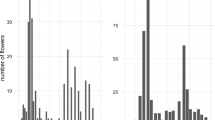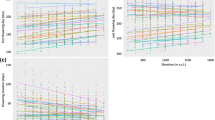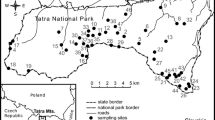Summary
We tested the adaptive significance of flowering synchrony by means of a quantitative analysis of selection and by flowering induction experiments with the deciduous shrubErythroxylum havanense. Temporal schedules of flower and fruit production were determined for a local population (in three sites) in a Mexican seasonal forest for 2 years (1987–1988). The consequences of natural variation in flowering time (flowering initiation day) on maternal reproductive success (fecundity) were evaluated. We observed high levels of inter- and intraindividual flowering synchrony in 1987, but not in 1988 and this contrast was related to differences in rainfall patterns between the two years. A significant proportion (15.4%) of the phenotypic variation in flowering initiation day was accounted for by environmental variance. The expression of phenotypic variance of flowering time and, consequently, the opportunity for selection to act, are controlled by annual variation in rainfall. Despite the between-year difference in flowering synchrony, we detected a relatively intense directional selection on flowering initiation day in both years, but selection coefficients were of opposite sign (standardized directional gradients were −0.326 and 0.333 for 1987 and 1988, respectively). For both years there was a significant relationship between individual relative fitness and the number of neighbouring flowering plants in a given day, suggesting positive frequency-dependent selection.
Similar content being viewed by others
References
Arnold, S.J. and Wade, M.J. (1984a) On the measurement of natural and sexual selection: theory.Evolution 38, 709–19.
Arnold, S.J. and Wade, M.J. (1984b) On the measurement of natural and sexual selection: applications.Evolution 38, 720–34.
Augspurger, C.K. (1980) Mass flowering of a tropical shrub (Hybanthus prunifolius): influence on pollinator attraction and movement.Evolution 34, 475–88.
Augspurger, C.K. (1981) Reproductive synchrony of a tropical shrub: experimental studies on effects of pollinators and seed predators onHybanthus prunifolius (Violaceae).Ecology 62, 775–88.
Barton, N.H. and Turelli, M. (1989) Evolutionary quantitative genetics: how much do we know?Ann. Rev. Genet. 23, 337–70.
Beattie, A.J. (1971) Pollination mechanisms inViola.New Phytol. 70, 345–60.
Beattie, A.J., Breedlove, D.E. and Ehrlich, P.R. (1974) The ecology of the pollinators and predators ofFrasera speciosa.Ecology 54, 81–91.
Bronstein, J.L., Gouyon, P., Gliddon, C., Kjellberg, F. and Michaloud, G. (1990) The ecological consequences of flowering asynchrony in monoecious figs: a simulation study.Ecology 71, 2145–56.
Bullock, S. H. (1986a) Climate of Chamela, Jalisco, and trends in the south coastal region of Mexico.Arch. Met. Geophys. Bioclim., Ser. B 36, 297–316.
Bullock, S.H. (1986b) Observations and an experiment on synchronous flowering.Madroño 33, 223–4.
Bullock, S.H. and Solís-Magallanes, A. (1990) Phenology of canopy trees of a tropical deciduous forest in Mexico.Biotropica 22, 22–35.
Bullock, S.H., Martínez del Río, C. and Ayala, R. (1989) Bee visitation rates to trees ofProckia crucis (Flacourtiaceae) differing in flower number.Oecologia 78, 389–93.
Bulmer, M. (1989) Maintenance of genetic variability by mutation-selection balance: a child's guide through the jungle.Genome 31, 761–7.
Copland, B.J. and Whelan, R.J. (1989) Seasonal variation in flowering intensity and pollination limitation of fruit set in four co-occurringBanksia species.J. Ecol. 77, 509–23.
Dieringer, G. (1991) Variation in the individual flowering time and reproductive success ofAgalinis strictifolia (Scrophulariaceae).Am. J. Bot. 78, 497–503.
Domínguez, C.A. (1990) Consecuencias ecológicas y evolutivas del patrón de floración sincrónico y masivo de Erythroxylum havanense Jacq. (Erythroxylaceae). PhD thesis, Universidad Nacional Autónoma de México, México.
Endler, J.A. (1986)Natural Selection in the Wild. Princeton University Press, Princeton, NJ.
Falconer, D.S. (1981)Introduction to Quantitative Genetics (2nd edn). Longman, London.
Fisher, R.A. (1958)The Genetical Theory of Natural Selection. Dover, New York.
Frankie, G.W., Baker, H.G. and Opler, P.A. (1974) Comparative phenological studies of trees in tropical wet and dry forests in the lowlands of Costa Rica.J. Ecol. 62, 881–919.
Gentry, A.H. (1974) Flowering phenology and diversity in tropical Bignoniaceae.Ann. Missouri Bot. Garden 61, 728–59.
Gómez, J.M. (1993) Phenotypic selection on flowering synchrony in a high mountain plant,Hormathophylla spinosa (Cruciferae).J. Ecol. 81, 605–13.
Gross, R.S. and Werner, P.A. (1983) Relationships among flowering phenology, insect visitors, and seed set of individuals: experimental studies on four co-occurring species of goldenrod (Solidago: Compositae).Ecol. Monogr. 53, 95–117.
Janzen, D.H. (1969) Seed eaters versus seed size, number, toxicity and dispersal.Evolution 23, 1–27.
Janzen, D.H. (1976) Why bamboos wait so long to flower?Ann. Rev. Ecol. System. 7, 347–91.
Johnson, L.K. (1982) Foraging strategies and the structure of stingless bee communities in Costa Rica. InSocial Insects in the Tropics (P. Jaisson, ed.). University of Paris Press.
Johnson, L.K. and Hubbell, S.P. (1975) Contrasting foraging strategies and coexistence of two bee species on a single resource.Ecology 56, 1398–406.
Lande, R. and Arnold, S.J. (1983) The measurement of selection on correlated characters.Evolution 37, 1210–26.
Lott, E.J., Bullock, S.H. and Solís-Magallanes, J.A. (1987) Floristic diversity and structure of upland and arroyo forest in coastal Jalisco.Biotropica 19, 228–35.
Mori, S.A. and Pipoly, J.J. (1984) Observations on the ‘big-bang’ flowering ofMiconia minutiflora (Melastomataceae).Brittonia 36, 337–41.
Mosquin, T. (1971) Competition for pollinators as a stimulus for the evolution of flowering time.Oikos 22, 398–402.
Opler, P.A., Frankie, G.W. and Baker, H.G. (1976) Rainfall as a factor in the release, timing and synchronization of anthesis by tropical trees and shrubs.J. Biog. 3, 231–6.
Parker, G.A. (1984) Evolutionary stable strategies. InBehavioral Ecology (J.R. Krebs and N.B. Davis, eds.). Sinauer, Sunderland, MA.
Rathcke, B. (1983) Competition and facilitation among plants for pollination. InPollination Biology (L. Real, ed.). Academic Press, New York.
Rathcke, B. and Lacey, E.P. (1985) Phenological patterns of terrestrial plants.Ann. Rev. Ecol. System. 16, 179–214.
SAS Institute Inc. (1987)SAS/STAT Guide for Personal Computers, Version 6. SAS Institute, Cary, NC.
Schluter, D. (1988) Estimating the form of natural selection on a quantitative trait.Evolution 42, 849–61.
Schluter, D., Price, T.D. and Grant, P.R. (1985) Ecological character displacement in Darwin's finches.Science 227, 1056–9.
Snedecor, G.W. and Cochran, W.G. (1978)Statistical Methods. The Iowa State University Press, Iowa.
Sokal, R.R. and Rohlf, F.J. (1981)Biometry. W.H. Freeman, New York.
Turelli, M. (1988) Population genetics models for polygenic variation and evolution. InProceedings of the Second International Conference on Quantitative Genetics (B.S. Weis, E.J. Eisen, M.M. Goodman and R.J. Namkoong, eds.). Sinauer Associates, Sunderland MA.
Turner, H.N. and Young, S.Y. (1969)Quantitative Genetics in Sheep Breeding. MacMillan, Melbourne.
Williams, G.C. (1992)Natural Selection. Oxford University Press.
Author information
Authors and Affiliations
Rights and permissions
About this article
Cite this article
Domínguez, C.A., Dirzo, R. Rainfall and flowering synchrony in a tropical shrub: Variable selection on the flowering time ofErythroxylum havanense . Evol Ecol 9, 204–216 (1995). https://doi.org/10.1007/BF01237757
Issue Date:
DOI: https://doi.org/10.1007/BF01237757




